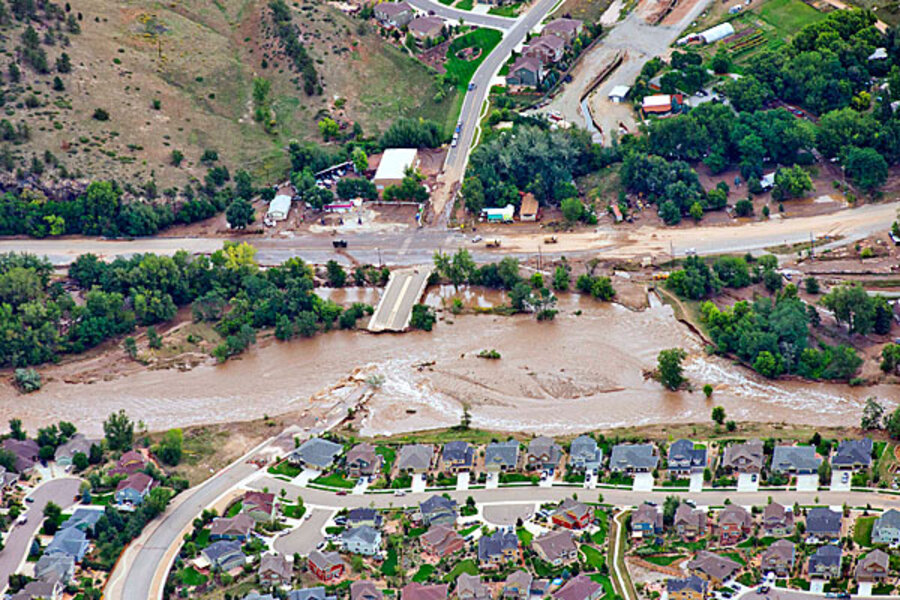Colorado floodwaters cover area the size of Connecticut
Loading...
| Lyons, Colo.
By air and by land, the rescue of hundreds of Coloradoans stranded by epic mountain flooding accelerated Saturday as debris-filled rivers became muddy seas that extended into towns and farms miles from the Rockies.
Helicopters and hundreds of National Guard troops searched miles of mountainous terrain for people as food and water supplies ran low in remote communities cut off since Thursday. Thousands were being driven from their homes in convoys.
For the first time since the harrowing floods began Wednesday, Colorado got its first broad view of the devastation. Floodwaters have affected parts of a 4,500-square-mile (11,655-square-kilometer) area — an area the size of the U.S. state of Connecticut.
A woman was missing and presumed dead after witnesses saw floodwaters from the Big Thompson River destroy her home in the Cedar Cove area, Larimer County sheriff's spokesman John Schulz said.
"We're sure there are going to be additional homes that have been destroyed, but we won't know that for a while," Schulz said. "I expect that we're going to continue to receive reports of confirmed missing and confirmed fatalities throughout the next several days."
Four people have been confirmed dead since the harrowing floods began Wednesday. More than 170 people remained unaccounted for in Boulder County, but that number could include people who are still stranded or who escaped but have not made contact yet, said Boulder County Sheriff Joe Pelle.
National Guard helicopters flew in and out of the mountain hamlet of Jamestown late into Friday night after it became isolated by rushing water that scoured the canyon the village sits in. Rescuers on the ground focused on the town of Lyons, a gateway community to Rocky Mountain National Park.
By Saturday morning, the Guard had evacuated nearly 800 people by air and ground.
More than a dozen helicopters were available to aid with rescue efforts.
"We have the ability to go whenever, wherever," Master Sgt. Cheresa Theiral said.
Still more rain was expected Saturday. And the outlook for anyone who preferred to stay behind was bleak: weeks without power, cellphone service or running water.
"Essentially, what they were threatening us with is, 'If you stay here, you may be here for a month,'" said 79-year-old Dean Hollenbaugh, who was evacuated by helicopter from Jamestown, northwest of Boulder.
For those awaiting an airlift, Guardsmen dropped food, water and other supplies to residents of the winding, narrow canyons that cut through the Rocky Mountain foothills.
As the waters rose, thousands of people fled mountain and downriver towns, where rivers were still swelling and spilling over their banks Saturday.
One was Mary Hemme, 62, who displayed a pair of purple socks as she sat outside the Lifebridge Christian Church in Longmont. They're a memento of the more than 30 hours she spent in an elementary school in the flood-stricken mountain town of Lyons. Many evacuees — eventually rescued by National Guard trucks — got socks because most of them had wet feet, Hemme said.
She recalled the sirens blared at 2:30 a.m. Wednesday.
"Mary we have to go, this place is flooding," she recalled her friend Kristen Vincent saying as they clambered out of a trailer.
Soon the trailer, like others in the park where she was staying, was submerged.
Hemme said she walked up a hill at daybreak and surveyed the trailer park.
"The most terrifying thing was when I climbed up on that cliff and looked down. It was the meanest, most — I mean, no wonder it carries cars like toys," Hemme said. "I was so afraid that I was going to die, that water came so fast."
The days-long rush of water from higher ground turned towns on Colorado's expansive eastern plains into muddy swamps. Crews used inflatable boats to rescue families and pets from stranded farmhouses. Some evacuees on horseback had to be escorted to safe ground.
The city of Boulder reported late Friday that the rushing waters had caused "a significant breach in its main wastewater pipeline" to the treatment plant, but officials said it would not affect drinking water.
Near Greeley, some 35 miles (56 kilometers) east of the foothills, broad swaths of farmland had become lakes, the Greeley Tribune reported.
Hundreds of roads were closed or damaged by floodwaters, and a 70-mile (113-kilometer) stretch of Interstate 25 was closed from Denver to the Wyoming line.
Rocky Mountain National Park closed Friday, its visitors forced to leave via the 60-mile (96-kilometer) Trail Ridge Road to the west side of the Rockies.
___
Neary reported from Longmont. Associated Press writers David Martin in Boulder, Mead Gruver in Fort Collins, and Colleen Slevin and Thomas Peipert in Denver contributed to this report.
Copyright 2013 The Associated Press. All rights reserved. This material may not be published, broadcast, rewritten or redistributed.







